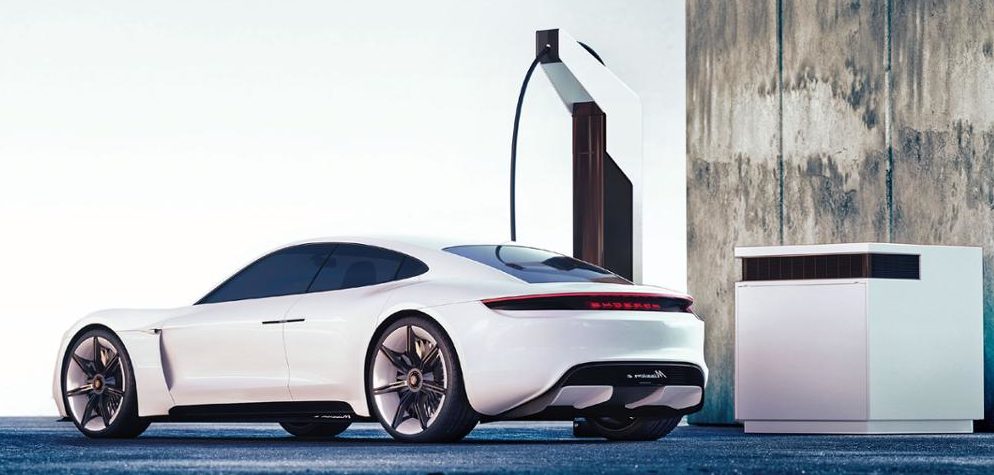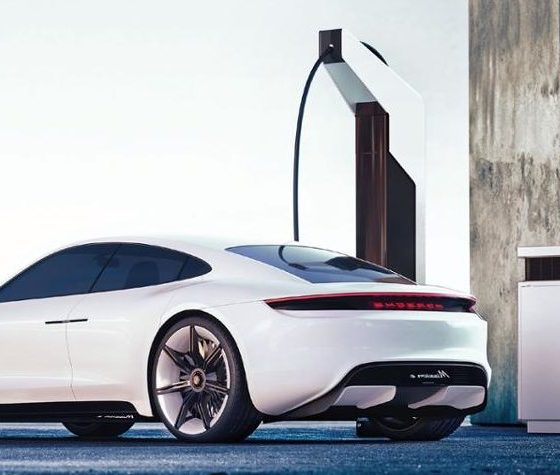

News
Porsche reveals details on the Taycan’s Electric Pit Stop charging system
Back in August, Otmar Bitsche, Porsche’s Director of Development Electrics, Electronics, and Electromobility outlined the idea for the Taycan’s dedicated charging solution. While speaking about the charging system that would be supporting the all-electric sedan, Bitsche mentioned the legacy automaker’s upcoming charging parks, which will host the company’s in-house charging systems.
Porsche’s charging parks are not unlike Tesla’s Supercharger Network, in the way that they would be set up in key locations that enable owners to charge their vehicles in a way that is convenient and quick. New details on this charging system were recently released, and the company has even revealed its name — the Electric Pit Stop.
Porsche’s Electric Pit Stops utilize a clever design that includes weatherproof, modular blocks called FlexBoxes. These FlexBoxes are outfitted with all the necessary components of a standard charging rack, but due to its modular structure, the units could be positioned a distance away from the PowerBox (the unit that contains the actual charging cable). True to their moniker, the FlexBoxes are pretty flexible, as Porsche could have them installed behind buildings or hedges, helping the PowerBox maintain a sleek, futuristic appearance.
The German legacy automaker notes that the charging parks also feature low operating costs, considering that the system is equipped with intelligent functions. The control server of the transformer station, for one, is capable of bringing together all the information from multiple control units of the charging hardware. Porsche notes that such a system boosts efficiency by up to 95%, making the Electric Pit Stops cheaper to maintain than comparable charging systems in the market today.
Apart from the FlexBox, Porsche also discussed the design of the ChargeBox, which is equipped with both a power unit and an additional battery storage unit that recharges when no vehicle is plugged in. Just like the FlexBoxes, Porsche’s ChargeBoxes are modular, making them ideal for areas without medium-voltage grid connections. The ChargeBox will be rolled out in two configurations — an entry-level model with a 70 kWh battery and a 160 kW charging station.
Perhaps most notable in Porsche’s recent announcement of its Electric Pit Stops is that the entire system will be compatible with all electric vehicles from every manufacturer in the future. This seems to be a direct response to Tesla’s statement back in the Q1 2018 earnings call, when Elon Musk noted that any interested electric car maker could partner with the Supercharger Network provided that they pay a fee and use an adapter.
“The idea is for electric vehicles from all manufacturers to be able to charge up here. A large, 10-inch touch display offers a wide variety of options for interacting with the customer. Altogether, this meticulously devised concept is intended to ensure that the customer’s experience of the charging process is uncomplicated and pleasant,” Porsche wrote.
Porsche’s Electric Pit Stops would likely start operations when the Taycan, the company’s first all-electric car, begins rolling out sometime next year. The company is yet to reveal the final production version of the upcoming vehicle, but it has already opened pre-orders for the all-electric car. Back in July, Porsche Managing Director Alexander Pollich noted that so far, the reception to the Taycan from the company’s customers has been incredibly encouraging.
The full details of Porsche’s Electric Pit Stops could be accessed here.

Elon Musk
Elon Musk’s X will start using a Tesla-like software update strategy
The initiative seems designed to accelerate updates to the social media platform, while maintaining maximum transparency.

Elon Musk’s social media platform X will adopt a Tesla-esque approach to software updates for its algorithm.
The initiative seems designed to accelerate updates to the social media platform, while maintaining maximum transparency.
X’s updates to its updates
As per Musk in a post on X, the social media company will be making a new algorithm to determine what organic and advertising posts are recommended to users. These updates would then be repeated every four weeks.
“We will make the new 𝕏 algorithm, including all code used to determine what organic and advertising posts are recommended to users, open source in 7 days. This will be repeated every 4 weeks, with comprehensive developer notes, to help you understand what changed,” Musk wrote in his post.
The initiative somewhat mirrors Tesla’s over-the-air update model, where vehicle software is regularly refined and pushed to users with detailed release notes. This should allow users to better understand the details of X’s every update and foster a healthy feedback loop for the social media platform.
xAI and X
X, formerly Twitter, has been acquired by Elon Musk’s artificial intelligence startup, xAI last year. Since then, xAI has seen a rapid rise in valuation. Following the company’s the company’s upsized $20 billion Series E funding round, estimates now suggest that xAI is worth tens about $230 to $235 billion. That’s several times larger than Tesla when Elon Musk received his controversial 2018 CEO Performance Award.
As per xAI, the Series E funding round attracted a diverse group of investors, including Valor Equity Partners, Stepstone Group, Fidelity Management & Research Company, Qatar Investment Authority, MGX, and Baron Capital Group, among others. Strategic partners NVIDIA and Cisco Investments also continued support for building the world’s largest GPU clusters.
News
Tesla FSD Supervised wins MotorTrend’s Best Driver Assistance Award
The decision marks a notable reversal for the publication from prior years, with judges citing major real-world improvements that pushed Tesla’s latest FSD software ahead of every competing ADAS system.

Tesla’s Full Self-Driving (Supervised) system has been named the best driver-assistance technology on the market, earning top honors at the 2026 MotorTrend Best Tech Awards.
The decision marks a notable reversal for the publication from prior years, with judges citing major real-world improvements that pushed Tesla’s latest FSD software ahead of every competing ADAS system. And it wasn’t even close.
MotorTrend reverses course
MotorTrend awarded Tesla FSD (Supervised) its 2026 Best Tech Driver Assistance title after extensive testing of the latest v14 software. The publication acknowledged that it had previously criticized earlier versions of FSD for erratic behavior and near-miss incidents, ultimately favoring rivals such as GM’s Super Cruise in earlier evaluations.
According to MotorTrend, the newest iteration of FSD resolved many of those shortcomings. Testers said v14 showed far smoother behavior in complex urban scenarios, including unprotected left turns, traffic circles, emergency vehicles, and dense city streets. While the system still requires constant driver supervision, judges concluded that no other advanced driver-assistance system currently matches its breadth of capability.
Unlike rival systems that rely on combinations of cameras, radar, lidar, and mapped highways, Tesla’s FSD operates using a camera-only approach and is capable of driving on city streets, rural roads, and freeways. MotorTrend stated that pure utility, the ability to handle nearly all road types, ultimately separated FSD from competitors like Ford BlueCruise, GM Super Cruise, and BMW’s Highway Assistant.
High cost and high capability
MotorTrend also addressed FSD’s pricing, which remains significantly higher than rival systems. Tesla currently charges $8,000 for a one-time purchase or $99 per month for a subscription, compared with far lower upfront and subscription costs from other automakers. The publication noted that the premium is justified given FSD’s unmatched scope and continuous software evolution.
Safety remained a central focus of the evaluation. While testers reported collision-free operation over thousands of miles, they noted ongoing concerns around FSD’s configurable driving modes, including options that allow aggressive driving and speeds beyond posted limits. MotorTrend emphasized that, like all Level 2 systems, FSD still depends on a fully attentive human driver at all times.
Despite those caveats, the publication concluded that Tesla’s rapid software progress fundamentally reshaped the competitive landscape. For drivers seeking the most capable hands-on driver-assistance system available today, MotorTrend concluded Tesla FSD (Supervised) now stands alone at the top.
News
Elon Musk’s Grokipedia surges to 5.6M articles, almost 79% of English Wikipedia
The explosive growth marks a major milestone for the AI-powered online encyclopedia, which was launched by Elon Musk’s xAI just months ago.

Elon Musk’s Grokipedia has grown to an impressive 5,615,201 articles as of today, closing in on 79% of the English Wikipedia’s current total of 7,119,376 articles.
The explosive growth marks a major milestone for the AI-powered online encyclopedia, which was launched by Elon Musk’s xAI just months ago. Needless to say, it would only be a matter of time before Grokipedia exceeds English Wikipedia in sheer volume.
Grokipedia’s rapid growth
xAI’s vision for Grokipedia emphasizes neutrality, while Grok’s reasoning capabilities allow for fast drafting and fact-checking. When Elon Musk announced the initiative in late September 2025, he noted that Grokipedia would be an improvement to Wikipedia because it would be designed to avoid bias.
At the time, Musk noted that Grokipedia “is a necessary step towards the xAI goal of understanding the Universe.”
Grokipedia was launched in late October, and while xAI was careful to list it only as Version 0.1 at the time, the online encyclopedia immediately earned praise. Wikipedia co-founder Larry Sanger highlighted the project’s innovative approach, noting how it leverages AI to fill knowledge gaps and enable rapid updates. Netizens also observed how Grokipedia tends to present articles in a more objective manner compared to Wikipedia, which is edited by humans.
Elon Musk’s ambitious plans
With 5,615,201 total articles, Grokipedia has now grown to almost 79% of English Wikipedia’s article base. This is incredibly quick, though Grokipedia remains text-only for now. xAI, for its part, has now updated the online encyclopedia’s iteration to v0.2.
Elon Musk has shared bold ideas for Grokipedia, including sending a record of the entire knowledge base to space as part of xAI’s mission to preserve and expand human understanding. At some point, Musk stated that Grokipedia will be renamed to Encyclopedia Galactica, and it will be sent to the cosmos.
“When Grokipedia is good enough (long way to go), we will change the name to Encyclopedia Galactica. It will be an open source distillation of all knowledge, including audio, images and video. Join xAI to help build the sci-fi version of the Library of Alexandria!” Musk wrote, adding in a later post that “Copies will be etched in stone and sent to the Moon, Mars and beyond. This time, it will not be lost.”








